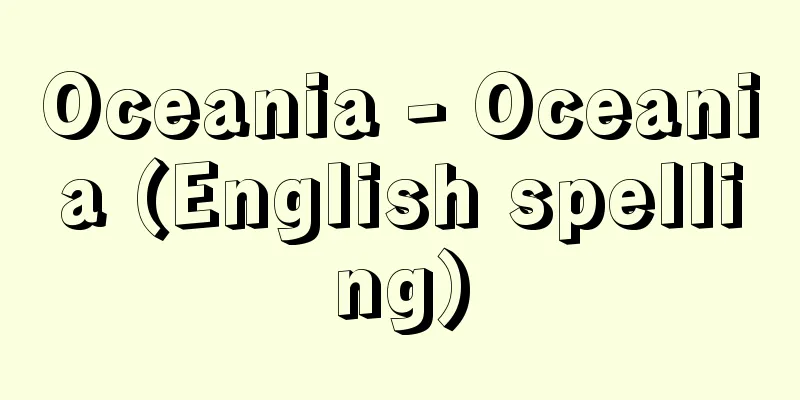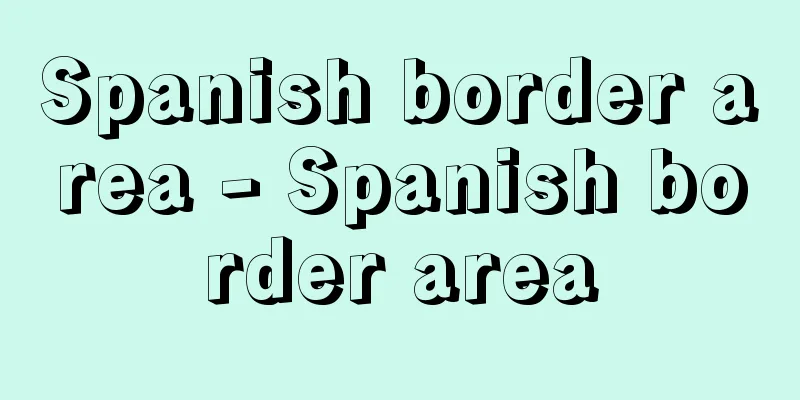Oceania - Oceania (English spelling)

|
It is also called Oceania. The name "Oceania" has only recently been used, believed to have been around since the 18th century, but there is currently no consensus as to the exact geographical extent of Oceania. It is more of a general term that includes the oceans stretching from the Central Pacific to the South Pacific, as well as Australia and New Zealand. Therefore, Oceania is literally a geographical concept centered on the ocean. The current total population, including Australia and New Zealand, is about 29 million, and the land area is about 8.5 million square kilometers, making it the smallest of the six major continents in terms of both area and population. Based on cultural and racial divisions, this region is roughly divided into Micronesia (meaning small islands) located north of the equator, Melanesia (meaning black islands) south of the equator and west of the International Date Line, Polynesia (meaning many islands) also to the east, and Australia and New Zealand, where the majority of people are of European descent. In Micronesia and Polynesia, the people's skin is light brown like that of East Asians, and at birth they have Mongolian spots on their lower back, which strongly indicates Asian characteristics. In contrast, Melanesians are dark brown or closer to black, and show characteristics of southern Asians. Australia and New Zealand are both dominated by white British people who immigrated there in the 18th and 19th centuries, but the indigenous people in Australia are called Aborigines, and their origins are unclear. The indigenous people of New Zealand are called Maori, and are of Polynesian descent. The indigenous people of Hawaii are also Polynesian, but they are now a very small minority, and Polynesian culture only survives in the performing arts. There is still debate as to when and how people migrated to the islands of Oceania. Lapita pottery found in the area indicates that 3,000 to 4,000 years have passed, but there are no clues going back any further than that. There are two theories about the migration route: a direct voyage from the Asian continent, or migration from South America. Both theories have cultural traces of their respective origins, and the Asian theory is more likely. However, Norwegian scholar Heyerdahl, who claims that people migrated from South America, once conducted a drifting experiment in 1947 on a raft called the Kon-Tiki from Santiago, Chile, and arrived at the Marquesas Islands in Polynesia after just over 100 days, demonstrating an easy way for people to migrate from South America. Europeans began to flow into Oceania, including Australia and New Zealand, between the end of the 18th century and the first half of the 19th century. In the early 19th century, missionaries, mainly from the London Missionary Society, arrived in the area, and people rapidly converted to Christianity. As a result, traditional indigenous religions such as ancestor worship and animism declined, and Christianity has now become the dominant religion in the area, except for Maori, Aborigines, and the mountain people of Papua New Guinea. However, traditional communal ways of thinking still remain strong in people's daily lives, and Oceanian values are evident in everyday food, clothing, and shelter, as well as in ritual acts such as weddings and funerals. Oceania was colonized by European countries in the 19th century, but even before that, the people of the region were victims of the slave trade, and the plagues brought by Europeans decimated the population by an estimated one-third in many areas. It was after the 1960s, after the Second World War, that the people of Oceania established their own independent nations. The 1970s was the period of independence for Oceania, with Western Samoa (now Samoa) in 1962, followed by Nauru, Tonga, Fiji, Papua New Guinea, Solomon Islands, Tuvalu, Kiribati, Vanuatu, and others. However, even now, the Micronesian islands of Guam and the Mariana Islands are de facto overseas territories of the United States of America (hereafter referred to as the United States), and there are many other non-independent territories, such as French Polynesia, centered on Tahiti, New Caledonia, and American Samoa. Of these, New Caledonia experienced a bloody tragedy over independence. In addition, the Micronesian islands of Palau, the Federated States of Micronesia, and the Marshall Islands are "freely associated states" that transfer defense and related diplomatic authority to the United States. There is debate under international law as to whether these should be considered independent nations. Polynesia also has the Cook Islands and Niue, which are in free association with New Zealand. Thus, there are still politically unresolved issues in Oceania. The following chapters will focus on countries in the Oceania region other than Australia and New Zealand. [Yasuhisa Takahashi] NatureRegional structureOceania is divided into three regions: the ocean islands (volcanic islands and coral islands) from Polynesia to Micronesia, the land islands from Melanesia to New Zealand, and the Australian continent, which is part of the Gondwana continent. The Circum-Pacific orogenic belt has had a major influence on the geology and topography of the Cenozoic Era. In the western Pacific Ocean, an archipelago is formed, and it is an unstable region that coincides with the distribution of earthquake belts. It is rich in andesite-based rocks containing silica, and forms a belt-like zone several hundred kilometers wide on the continental side from a tectonic line called the andesite line. In other words, it forms a boundary zone between the granite siales on the continental side and the basaltic islands on the ocean floor. The islands in this region are andesite-based because there is a siales layer with a lot of silica at the bottom of the islands, and the basaltic magma is transformed into andesite on the way from the inside of the crust to the surface. The andesite line almost coincides with the trench, runs south along the east side of the Japanese archipelago, passes the west side of the Caroline Islands, continues north of New Guinea, goes around the north of the Solomon Islands, Fiji, and Samoa islands, runs south at a right angle, brushes against the east of the Tonga Trench and the Kermadec Trench, and continues east of New Zealand. [Takashi Asagiya] Geology and topographyMost of the islands from Polynesia to Melanesia are volcanic islands made of basalt or coral reef islands with volcanic bases. Volcanic islands are cone-shaped mountains that emerge above sea level. They are huge volcanic bodies, reaching heights of 5,000 to 10,000 meters above the ocean floor. As they can be seen from afar, they are called "high islands" and many have fringing reefs. The Hawaiian Islands, Tahiti, and Rarotonga (Cook Islands) are prime examples. In particular, Mauna Kea in Hawaii rises 4,205 meters above sea level from the ocean floor 5,500 meters above sea level, making it one of the highest in the world. Coral reefs are limited to tropical waters and volcanic foundations. They are generally low-lying, so they are called "low islands" in contrast to high islands. Atolls are the most common type of coral reef, with a landmass (reef state) surrounding a central lagoon (lagoon) in an almost circular shape. Most of the Marshall Islands, Gilbert Islands, Line Islands, and Tuamotu Islands are examples of this type, and they vary in diameter from 1-2 kilometers to several tens of kilometers. Kwajalein Atoll (Marshall Islands) is the largest in the world, with a major axis of 126 kilometers and a minor axis of 32 kilometers. Raised coral reefs have makatea (limestone plateaus) and generally have an area of several tens of square kilometers or less, with the exception of Niue, which has an area of about 260 square kilometers. Ocean Island, Nauru Island, Makatea Island (Tuamotu Islands), and Tongatapu Island (Tonga Islands) are examples of this type, but they are not very numerous. The land islands are part of the Pacific Circum-Pacific orogenic belt, and the Melanesian islands stretching from New Guinea to the east make up the majority of them. New Guinea is the second largest island in the world, and its shape is likened to a phoenix. A Tertiary folded mountain range stretches for 2,400 km from the "Bird's Head" at the western end to the Owen Stanley Mountains in the east, with Mount Jaya reaching an elevation of 5,030 m. To the north of this mountain backbone lies the Sepik River, and to the south the Digul and Fly Rivers, which form open alluvial plains. Although somewhat small, the Rewa River and its estuary stretch southeast of Viti Levu, the main island of Fiji, are found. Few other land islands have large rivers or broad plains. [Takahiro Asagiya and Yasumasa Takahashi] climateMost of the islands of Oceania are located between the Tropics of Cancer and the Tropics of Cancer, and belong to the tropics. On the other hand, the Australian continent and the central and eastern Pacific Ocean are covered by a dry zone, which is the largest among the six continents. The climate of the Pacific islands is mainly determined by the atmospheric pressure distribution and the associated wind system. As there is very little land, the trade winds and westerly winds are remarkably dominant and regular. However, in the northeastern part of Australia, the monsoon winds develop and disrupt the large-scale wind system. In January, the center of the mid-latitude high pressure belt is located north of the Hawaiian Islands, around 30 degrees north latitude, in the northern hemisphere, and south of Easter Island, around 30 degrees south latitude, in the southern hemisphere. On the other hand, the equatorial low pressure area extends widely from east to west, centered on New Guinea. In July, the high pressure areas in both the north and south increase in strength and move north by about 10 degrees latitude. The low pressure area also moves north to the Caroline Islands. Therefore, the intratropical convergence zone, where the southeasterly and northeasterly trade winds meet, is located south of the equator in January, but moves north of the equator in July, running east-west at approximately 5-10 degrees north latitude. The climate of the Pacific islands is divided into five regions: the northeasterly trade wind region, the equatorial rainy region, the eastern dry region, the southeasterly trade wind region, and the westerly wind region. The northeast trade winds zone stretches from east to west between 10 and 40 degrees north latitude, and includes the Hawaiian Islands and the Mariana Islands. The northeast trade winds are felt all year round, bringing heavy rain to the windward side of the high islands, with a large difference from the leeward side. The Hawaiian Islands receive more than 5,000 mm of annual precipitation on the windward side, while Honolulu receives only 556 mm on the leeward side. The equatorial heavy rain zone includes New Guinea and the Solomon Islands. The southeast trade winds dominate from late summer to autumn, but the northeasterly and southeasterly winds converge in this zone from late winter to spring, resulting in heavy rain all year round. The eastern dry zone stretches from Nauru to the eastern seas, passing through Christmas Island and the Phoenix Islands. This is because the atmosphere is stable due to the low-temperature South Equatorial Current, which is connected to the Humboldt Current (Peru Current), and the tropical front is poorly developed. On Christmas Island, the annual precipitation sometimes falls below 1,000 mm, and vegetation is poor. The southeasterly trade winds district includes the Marquesas, Cook, Tonga, Fiji, etc., and is dominated by southeasterly trade winds, but the wind direction becomes somewhat unstable from November to March and April when the intratropical convergence zone moves south. Suva on Viti Levu island in the Fiji Islands is on the windward side, and has an annual rainfall of 3,073 mm, while Labasa on the leeward side of Vanua Levu island has an annual rainfall of 2,030 mm, which is considerably less than Suva. The westerly wind district stretches from east to west in a band from around 30 degrees south latitude, and the southern edge is known for strong winds. [Takashi Asagiya] FaunaOceania has many unusual animals, unlike other continents. The Dutch zoologist Weber studied the distribution of freshwater fish in the Malay Archipelago and hypothesized the Weber Line. This line is an S-shaped line that passes through the Ceram Sea and the Timor Sea, and it is known that the further east you go from this line, the more Australian-related animals there are. This indicates that in ancient geological times, Melanesia and Australia were separated from other continents, and mammals and other animals followed a special evolutionary path, resulting in the birth of unique creatures such as marsupials and monotremes that do not have placentas. New Guinea and the Hawaiian Islands, which will be described later, are relatively rich in terrestrial animals. Marsupial wallabies and monotremes such as the platypus can be found in New Guinea, but there are no native primates or ungulates. In other islands, there are very few mammals, except for those that are easy to migrate on ships or driftwood, such as the house mouse. Pigs, goats, and cows that are commonly seen today were brought from other places. Crocodiles can be found in New Guinea, and snakes are common in New Guinea and the Solomon Islands, with a few in Fiji and Samoa. The Pacific islands are rich in seabirds that move freely over the ocean and breed on isolated islands, with unique species such as the New Guinea bird of paradise, the flightless emu, and the cassowary. The Hawaiian Islands are rich in fauna, with many endemic species. Of the approximately 6,000 species of insects, over 60% are endemic species that have evolved to adapt to the island environment, and there are also many endemic bird species, such as the Hawaiian honeyeater. However, no freshwater fish, amphibians, or reptiles live there other than those that have been introduced. [Akio Nizuma and Takehiro Asagiya] FloraLand islands such as New Guinea have a very rich variety of plants because they are mixed with plants originating from Eurasia. In oceanic islands, endemic species have been preserved due to their isolation, and many have evolved individually. In the Hawaiian Islands, more than 70% of the natural plants are endemic to the region. Tropical rainforests are prominent on large islands such as New Guinea, and due to the high temperatures and humidity, undergrowth such as bamboo, rattan, and ferns grows densely between the tall trees, and parasitic plants grow on the tree trunks. Tropical rainforests are also found in parts on small islands, and rainforests are formed on the windward side of the prevailing winds on Viti Levu Island in Fiji and Tuamotu Island in Samoa. Although not a tropical rainforest, New Guinea has coniferous forests such as African cedar and Araucaria in the inland highlands, and as the altitude increases, they transition to beech. Coastal vegetation is common on ocean islands, and is the only vegetation found on coral reefs. Salt-tolerant coconut palms, pandanus, nipa palm, Balintonia, and Casuarina grow naturally, and mangrove communities form in the intertidal zone. Coconut palms and pandanus in particular are important sources of livelihood for the inhabitants. [Akio Nizuma and Takehiro Asagiya] historyIn 1513, the Spaniard Balboa became the first European to see the Pacific Ocean from the Isthmus of Panama, and it is said that he named it the "South Sea" because it was seen in the south direction. In 1520, the Portuguese Magellan led five ships under the Spanish flag and set out to cross this unknown ocean, and after 98 days of hardship, he arrived at the Mariana Islands on March 6, 1521. Since the voyage after leaving the Strait of Magellan was blessed with calm weather, this ocean was named the "Pacific Ocean." The islands were originally named "Islands of the Latin Sails" after the triangular sails of the natives, but due to plundering by the natives, the name was changed to "Ladrones Islands" (Islands of Robbers) (it was not until 1668 that they came to be called the Mariana Islands). Magellan was later killed in the Philippines, but the surviving crew returned to Spain around the Cape of Good Hope, thus accomplishing the feat of circumnavigating the globe. After Magellan, the 16th century was a time of great Spanish activity, and Spain, emboldened by this success, sent out second and third expeditionary ships. However, the navigators at that time had no knowledge of the northeast trade winds, and could only cross the Pacific Ocean from east to west. In 1565, Urdaneta discovered that it was possible to navigate east using the westerly winds, and the Manila Galleon trade between the Philippines and Acapulco, Mexico, took place for 250 years. The Spanish explorers focused on the Americas and the Philippines, where they could obtain wealth, and paid no attention to Oceania. Manila was founded in 1571, and the Marianas began to be colonized in earnest. It is said that the reason for this was not only the purpose of spreading Christianity, but also the strategic importance of keeping out pirates from England and other countries, who were a threat to the Manila Galleon trade. Greek geographers had long believed that a large southern continent must exist to balance the size of the northern hemisphere. The main objective of the 1567 expedition by Spanish navigator Alvaro de Mendaña de Neyra (1541-1595) was to discover this continent and the legendary city of gold. He sailed from Peru and, strangely enough, passed between the Tuamotus and Marquesas Islands of Polynesia, and also near the Society Islands, without sighting the main Polynesian islands, but sighted one of the Ellice Islands, and finally reached the Solomon Islands, named after him on his return to New Spain (Nueba España, colonial Mexico) because of rumors that the place was full of untold treasures. On his return to America, he discovered part of the Marshall Islands. The Solomon Islands were considered somewhat mythical until they were rediscovered in 1767. In 1595, he made a second expedition to the Solomon Islands with Pedro Fernández de Queirós (1560?-1614). On his westward voyage from Peru, he discovered the islands, which he named Marquesas after the Peruvian governor. They were the first major Polynesian islands to come to European knowledge. He then reached the Santa Cruz Islands, but died before rediscovering the Solomon Islands. After returning to Peru, Quiro set sail from Callao in 1605 to search for the "Southern Continent". On this voyage, he encountered parts of the Tuamotu Islands, parts of several other islands in Polynesia, and the Melanesian island of Tikopia, before reporting that he had discovered the continent he was looking for, which was the island of Espiritu Santo in the New Hebrides. Váez de Torres, who left Quiroz's expedition, discovered the Torres Strait, which lies between New Guinea and Australia, on his way to explore westward. During the Spanish period, British and French pirates contributed to the discovery of several islands. Now, Dutch navigators tried to reach the East Indies via Cape Horn, the southern tip of Tierra del Fuego in South America. In 1616, Jacques Le Maire sailed around Cape Horn, named after his native country, and then passed through the Tuamotu Islands to discover the Horn Islands between Fiji and Samoa. He then passed the edge of the coast of New Ireland and New Guinea to discover the Admiralty Islands and the Short Islands. In 1642, Tasman explored Australia to determine the true nature of the "Southern Continent" and discovered Tasmania (which he mistakenly thought was part of the Australian continent) and New Zealand (which he thought was part of the "Southern Continent"). The following year, in 1643, he discovered Tonga and the Fiji Islands. In 1722, Jacob Roggeveen (1659-1729) discovered an island on Easter Day and named it Easter Island. He also discovered seven islands in the northern Tuamotu archipelago and the Manu'a Group in Eastern Samoa. After the Dutch came British and French explorers. Among them, the British explorer James Cook made many valuable contributions to scientific research, worthy of the name of a great explorer. From 1769 to 1778, he conducted three expeditions, discovering new islands such as New Caledonia and Hawaii, and disproving the theory of the "southern continent." From his second voyage in 1773, he used accurate navigational instruments invented by John Harrison to correctly redraw maps that had been unclear until then. He also had scientists and artists on board, who left behind various valuable records that have since been lost. Furthermore, he knew that scurvy, the disease that sailors feared the most, was caused by a lack of vitamin C, so he took preventive measures and succeeded in avoiding death. The discovery of the Polynesian islands by Europeans - or more accurately, "contact" since the indigenous peoples had already discovered and inhabited them - was not completed until 1835. It took more than 300 years for Europeans to discover all of the Polynesian islands after Magellan. In the 19th and 20th centuries, Oceanian islands became the prey of the world's great powers for colonization, ignoring the will of the indigenous peoples. This is deeply connected to the history of "discoveries" mentioned above, and except for Spain, whose national power had weakened, Britain and France fought fiercely to acquire the important islands before Germany appeared. Britain acquired Tonga, Solomon Islands, Fiji, Rotuma, Gilbert Islands, and Eris Islands, while France acquired Société, Tuamotu, Gambier Islands, Austral Islands, and Marquesas Islands, and the New Hebrides were placed under joint management. Germany, which appeared later, defied the protests of Australia and acquired the northern part of New Guinea, the Bismarck Islands, and further the Mariana Islands, Marshall Islands, and Caroline Islands from Spain. The United States acquired Hawaii, Guam, and parts of Samoa. After World War I, Japan, Australia, and New Zealand each divided and governed the former German territories. However, after World War II, this governance changed, and for example the Japanese Mandated Territory of Micronesia became a United Nations Trust Territory, with administrative authority being transferred to the U.S. However, since the late 1960s, an increasing number of islands across Oceania, including Micronesia, have been gaining independence. [Jun Takayama] Economy and IndustryOceania's industries are also diverse regionally. Australia has transformed from an agricultural and livestock country into a modern industrial country, and has a vast territory blessed with mineral resources. New Zealand is a primary industry nation, but is aiming for higher added value agriculture and livestock. Papua New Guinea has the potential to develop rich mineral resources such as gold, copper, and oil, and is rapidly strengthening its trade relations with Asian countries. The economies and industries of other island nations are facing various difficulties. The above three nations are planning to develop their economies by expanding trade and commerce with Asian countries, for example through APEC (Asia-Pacific Economic Cooperation). However, since the main products of all island nations are traditional tropical products (coconuts, bananas, taro, cassava, and sugar), they compete with products from Southeast Asian countries, and due to their competitiveness, export development is unlikely to be very good. Since the country gained independence in the 1970s, new industrial sectors such as coffee, vanilla, cocoa and pumpkin have been developed in the region. However, the region faces many problems due to its small geographical area, its remoteness from consumption areas, and the quality control of the products produced. Since the 1970s, fishing has become a key factor in the economic development of island nations. The Pacific Ocean is a globally important fishing ground for skipjack tuna and tuna, and in addition to conducting their own fishing activities, fishing fees have become a means of earning foreign currency. Japan's fisheries aid (ODA = Official Development Assistance and Private Fisheries Assistance) has played a major role in promoting the fishing industry, but since the end of the 20th century, the depletion of fishing resources has become a major problem. The imbalance between exports and imports is the biggest problem for island nations. Except for Australia, New Zealand, and Papua New Guinea, all nations in Oceania suffer from huge trade deficits (in some cases, imports are nearly 10 times the amount of exports). Island nations import not only industrial products such as automobiles, but most daily necessities, but they do not have the export power to match this. They make up for this trade deficit with tourism revenues, economic aid, and remittances from overseas workers. In order to promote the economies of island nations and increase exports, various promotion agreements have been offered, such as the export guarantees under the Lomé Agreement by the European Union (EU), the former colonial power, and trade preferences for primary products of island nations by Australia and New Zealand, but a fundamental solution has not been found. Economic aid to the region from developed countries totals approximately one billion dollars per year, of which Japan is the largest donor, excluding American aid to the Micronesian nations under the Compact of Free Association and Australian aid to the former trust territory of Papua New Guinea. Japan's aid is not biased toward any particular region or country, and is internationally recognized. [Yasuhisa Takahashi] Race and CultureWithin Oceania, Melanesia is the most racially, linguistically, and culturally complex, while Polynesia is the most homogeneous, and Micronesia is somewhere in between. These differences are mainly due to differences in the origins of the people, the long history of habitation, the degree of geographical and cultural isolation of the islands, and differences in the way people and cultures have adapted to the different ecological environments of each island. In particular, in the case of Polynesia, the fact that it was the last place to be inhabited in the history of human migration around the world is a major factor in the homogeneity of the Polynesian people. [Jun Takayama] PolynesiaIt is estimated that the ancestors of the Polynesians had already migrated from the Philippines and Indonesia to New Guinea and the Bismarck Archipelago around 4000-3000 BC. They had reached the Fiji Islands by 1300 BC, and Tonga and Samoa, the westernmost islands of Polynesia, a little later. They stayed there for more than 1000 years, successfully adapting to the new environment and creating the prototype of the later Polynesian culture, and then moved eastward toward the open seas. They probably set sail in double canoes, two boats connected side by side, and were people with excellent navigation skills, but they were agriculturalists belonging to the Neolithic cultural stage. Current archaeological research has revealed that they first arrived in the Marquesas Islands around 300 AD. After that, the site was based on this point, and colonized Easter Island in 400, Hawaii in 500, Hawaii in 600, and the Societe Islands, this time the forward base was settled on New Zealand in 800, Cook Islands around 1100, and Tuamotu Islands around 1200. Research into oral traditions in Hawaii and New Zealand suggests that they had migrated from the Societe Islands to both islands even in a relatively new era. There have been many hypotheses for the motives of migration, including escape to new lands due to race struggles caused by land shortages caused by population growth, discovery of islands due to accidental drifting and washing up, and the sense of adventure and curiosity towards the unknown world. Since Captain Cook in the 18th century, the issue of Polynesian origin has attracted European interest, and various hypotheses have been completely rejected today, including the lost "Mu Continent" theory. The fact that Polynesian ancestors have come from Southeast Asia is obviously a division of the Austronesian (Marai Polynesian) tribes found in Madagascar, Southeast Asia, Melanesia, and Micronesia. The Polynesian culture that Europeans encountered in the early years was nothing more than a witness to a culture that developed independently after the people had finished their migration to each island. Furthermore, there is no conclusive evidence to support the view that some interracial invasions were made in different eras in Polynesia, and it is said that there was little change in the original body traits of Polynesians until contact with Europeans. Furthermore, the opinion is becoming more and more promising, in contrast to the conventional wisdom that Polynesians belong to Caucasian (white) strains, as they are merely a lineage of Mongoloid (yellow-brown) strains. By the way, the Lapita style pottery culture is considered to hold an important key in exploring the prototypes of early Polynesian culture. Named after discovery at the excavation of the Lapita ruins in New Caledonia, this pottery has a unique pattern characterized by a "dentate" piercing, and is distributed from around the Bismark Islands to various parts of Melanesia to Tonga and Samoa in Western Polynesia. Other major artefacts include angular, plano-convex, lenticular cross sections, clasp and obsidian strips, stone tools, clasp and stone bombs, shell-made trinkets and net weights, and bone-made tattoo needles. Obsidian from New Britain was discovered in the Santa Cruz Islands, 2,000 kilometers away, so clearly indicates that the Lapita-style pottery bearers were excellent sailors who engaged in much wider trading than the ceremonial gift trade known in Melanesia. There is also a slight difference between the artefacts excavated from early ruins of both East and West Polynesia. For example, the stepped stone axes and fishing hooks were excavated only from East Polynesia. It is highly likely that these developed independently within East Polynesia. The differences between the two regions are also ethnically recognized, with no stone pestles or stone or wooden figures in Western Polynesia. になったんです。 English: The first thing you can do is to find the best one to do. By the way, the origins of Polynesian cultivated crops are always the subject of controversy in the sweet potatoes that have been cultivated in Hawaii, Easter Island, New Zealand, and, in a small way, Societe and Marquesas Islands before the arrival of the Caucasians. Linguistic and botanical studies have shown that this is clearly of Andean origin. However, apart from sweet potatoes, the influence from South America cannot be found in the Polynesian cultural elements, and as some scholars have argued, it is not possible to seek the origins of Polynesians and their cultures in South America. The origins of Polynesian sweet potatoes are shrouded in mystery. In other words, the stone statues on Easter Island are not originated from Peru, but are developed from wooden statues of the Marquesas Islands. [Takayama Jun] MelanesiaMelanesia is an area where people with dark skin, as its Greek origin, "Black Islands (Nesus)." They are classified primarily as Melanesians, Papuans, and Negrito due to differences in body traits. As the name "Papuan" comes from the Malay word "frizzy hair", they have significantly more frizz than people in other parts of Oceania. Because their black skin and vortex hairs are very similar to African negroids, they have long been classified as "Oceanic Negroids," but these characteristics are often denied on a variety of basis, such as merely superficial similarities. Some say that negrito is merely a trait-dwarf phenomenon that has resulted from the progenitors of the Papuans. Recent archaeological research reveals that human habitations in New Guinea and Australia date back 30,000 to 40,000 years ago, but perhaps they are thought to be black-skinned Australians, ancestors of today's Melanesians and indigenous Australians. However, it is not clear when they spread to the islands of Melanesian east of New Guinea and the Bismark Islands. At least before the Austronesian language stakeholders with Lapita-style pottery culture appeared here, they were already living in various parts of Melanesia. [Takayama Jun] MicronesiaMicronesia has a history of people's residence in the region of Melanesia, but because it is older, it does not show the same linguistic and cultural unity as Polynesian. Some people say that Yap and Nauru are unknown attribution, so I will exclude them. The western margin Chamorro (Mariana Islands) and Palau are systematically linked to the languages of the Philippines and Indonesia, while the eastern nuclear Micronesian (Trak, Ponape, Kusaiye, Marshall, Gilbert) are related to the languages of the Banks-New Hebrides Islands region of Eastern Melanesia. The languages of Nukuolo and Kapingamarangi Atoll are Polynesian (Melanesia also has islands inhabited by people who speak Polynesian and are Polynesian with their physical traits. They are called Polynesian Outliers, and are people who have returned westward from Polynesia). になったんです。 English: The first thing you can do is to find the best one to do. There are similarities between Micronesian and Polynesian cultures, but there are differences. Both fisheries are often important to livelihoods, as are farming. However, in regards to ocean canoes, triangular sails that can be quickly changed in response to changes in wind direction were invented in Micronesia, whereas in Polynesia, there were only double canoes with slower loads of ships. Along with Melanesia, there is a custom of binging the skewer in the western edge of Micronesia, but not in Polynesia. In the Caroline Islands of Micronesia, there is a loom (the material for the woven fabric is bananas and hibiscus fibers), but it is not found in Polynesia. There is also a considerable difference between Micronesia and Polynesia in social organizations and religions. [Takayama Jun] Japan and Oceaniaになったんです。 English: The first thing you can do is to find the best one to do. With the departure of the League of Nations (1933), the area was made into Japanese territory and promoted a policy of imperializing the residents, but with the defeat in 1945, the government ended. At the same time, Japanese trading companies, which had expanded their trade area from Micronesia to South of the Equator, New Zealand and Australia, also completely withdrawn from this area. From Micronesia in the Central Pacific Ocean, Melanesia was a fierce battleground during the Pacific War, and many countries still remain in battle, such as the Gilbert Islands, the Mariana Islands, the Western Caroline Islands, and the Papua New Guinea, which had been defeated by the Japanese army, and the Solomon Islands, which had experienced a tragic defeat. In Sydney, Australia, records of Japanese naval submarines infiltrating Botany Bay are on display at the museum. However, on the other hand, records of the Japanese Navy's warship Ibuki transporting New Zealand soldiers to the Mediterranean are also displayed at the Wellington Maritime Museum in New Zealand, as proof of friendship. Thus, the relationship between Japan and Oceania before World War II was a cross between light and shadow. になったんです。 English: The first thing you can do is to find the best one to do. Many of these are now localized and become important industries in their respective countries, contributing to the acquisition of foreign currency and increasing employment. Oceania's economic development is often extremely difficult compared to regions such as the Caribbean, Africa, and Asia. This is because it lacks international competitiveness due to its narrow land area, geographical remoteness from developed regions, and monoculture of its products. To cover these disadvantages, Japan has promoted technical cooperation across various fields, with the content being broadly diverse, including expansion of production and breeding. Since the 1980s, it has been strongly recognized that the foundation of all economic and social development in Oceania is the development of human resources, and in response, Japan's cooperation is also focused on humanitarian assistance (BHN) such as education, the environment, culture, and lifeline development. Although Japan is an observer of the Pacific Islands Forum (PIF), it is not an official member, but since 1997, it has organized the Japan-South Pacific Forum Summit Meeting, which has contributed to solving problems faced by the Pacific region, including the environment and technological advancement in the Pacific region. In May 2003, the third conference was held in Okinawa. In addition, it invited leaders of the Pacific universities to improve academic knowledge and technology, and supports joint research on environmental issues, agricultural and fisheries, information technology, and infectious disease countermeasures. In addition, the Pacific Academic Exchange Center was established at Ryukyu University in Okinawa. [Takahashi Yasumasa] "Cumverland, translated by Ishida Hiroshi and Asakitani Gohiro, "Southwest Pacific Ocean" (1972, Asakura Shoten) " ▽ "World Geography 11 Oceania" (1977, Asakura Shoten)" ▽ "World Geography Seminar VIII Oceania" (1977, Daimeido)" ▽ "Tanabe Hiroshi and translated by Tatsunami Tatsunami, Illustrated, "Illustrated Encyclopedia of the World Geography 23 Oceania and Antarctic" (1997, Asakura Shoten)" ▽ "Richard Nile and Christian Clark, supervised and translated by Watanabe Akio, translated by Kobayashi Izumi, Higashihiroshi and Fukushima Teruhiko, "Illustrated Encyclopedia of the World Culture Geography Oceania" (2000, Asakura Shoten)" ▽ "Encyclopedia of the World Geography 5 Asia and Oceania 2" (2002, Asakura Shoten) by Tanabe Yutaka and supervised by Sakurai Yusuke, Sato Tetsuo, Taniuchi Tatsuro, and Yamagishi Tomoko" (2002, Asakura Shoten)" (2002, Asakura Shoten) " (2002, Nihon Hyoronsha)" (2070, Nihon Hyoronsha)" (2078, Kadokawa Shoten)" (2079, Kadokawa Shoten)" (2079, Kadokawa Shoten) " (2078, Takayama Jun, Prehistory Culture of Micronesia (1983, Kainaisha)" (2083, Takahashi Yasumasa, Inoue Yoon, Kobayashi Izumi, Onuma Hisao, Onuma Contemporary Encyclopedia of Oceania (1987, Shinkokusha) " (ed.)" (2087 , Shinkokusha)" (ed.)" (2087, Shinkokusha)" (ed.)" (2087, E.L. of the World History of Ethnicity 14). "Traditional and Transformation of the Oceanian World" (1987, Yamakawa Publishing)" ▽ "Pacific: Human History of Southeast Asia and Oceania" by Peter Bellwood, translated by Ueki Takeshi and Hattori Kenji (1989, Hosei University Press)" ▽ "Takayama Jun, Ishikawa Eikichi, and Takahashi Yasumasa, "World History from Regions 17 Oceania" (1992, Asahi Shimbun )" ▽ "Oceania 1-3" edited by Otsuka Yanagitaro, Katayama Kazumichi, and Into Michiko " ▽ "Oceania 1-3" ▽ "Roslyn Poinyant, translated by Toyota Yukio (1993, Seidosha)" ▽ "Immigration History 2: Asia and Oceania Edition" expanded edition (1996, Shinsensha)" ▽ "Kasuga Naoki, Oceania Orientalism (1999, Sekai Shisosha)" ▽ "Ishikawa Eikichi, Ochi Michio, Kobayashi Izumi, and Momoyuko, "Newly revised and expanded edition of "The Dictionary of Knowing Oceania" (2000, Heibonsha)" ▽ "Yamamoto Matori, "New Edition: History of Worldwide 27: History of Oceania" (2000, Yamakawa Publishing)" ▽ "Kuroyanagi Yoneji, Sekine Masami, and Hirose Takako, "Southeast and South Asia/Oceania: Understanding the News from Modern History" (2001, Jiyukunisha)" ▽ "Hashimoto Seiji, "Taromo Crossing the Sea: A Agricultural Culture in the Oceania and the Nansei Islands" (2002, Kansai University Press)" ▽ "Kawai Toshimitsu, "The Present of Oceania: Ethnography of Continuity and Transformation" (2002, Jinshoin)" ▽ "Kasuga Naoki, Oceania Postcolonial (2002, Kokusai Shoin)" ▽ "Into Michiko, Oceania: Archaeology of Life" (2002, Asahi Shimbun, Inc.)" [References] | | | | | | | | | | | | | | | | | | Guinea | | | | | | | | | | | | | | |Source: Shogakukan Encyclopedia Nipponica About Encyclopedia Nipponica Information | Legend |
|
大洋州ともいう。「オセアニア」の名称が使用されたのは新しく、18世紀以降とされているが、オセアニアの地理的範囲の確定については、現在、かならずしも定説があるとはいえない。いずれかといえば、中部太平洋から南太平洋に広がる海域とオーストラリア、ニュージーランドを含む総称である。したがって、オセアニアは、文字どおり海洋を中心とする地理概念である。現在の総人口はオーストラリア、ニュージーランドを含めて約2900万人、陸地面積は約850万平方キロメートルで、面積、人口とも六大州では最小である。 この地域は、文化的あるいは人種的区分から、おおむね赤道以北に位置するミクロネシア(小さな島々の意)、赤道以南で日付変更線以西のメラネシア(黒い島々の意)、同じく以東のポリネシア(多くの島々の意)およびヨーロッパ系人種が多数を占めるオーストラリア、ニュージーランドに区分される。 ミクロネシアとポリネシアでは、人々の肌の色は東アジア人同様の明るい褐色で、出生時腰部に児斑(蒙古(もうこ)斑)を残すなど、アジア系人種の特徴を強く示している。これに対して、メラネシア人は、濃い褐色もしくは黒色に近く、南方系アジア人の特徴を示している。オーストラリアとニュージーランドは、いずれも18~19世紀にかけて移住してきたイギリス系白色人種が多数派であるが、先住民は、オーストラリアではアボリジニーとよばれ、その起源は明確ではない。ニュージーランドの先住民は、マオリとよばれ、ポリネシア系人種である。ハワイも先住民はポリネシア人であるが、いまやごく少数となり、ポリネシア文化は芸能などにわずかに残存する程度となっている。 オセアニアの島嶼(とうしょ)に、いつ、どのように人々が移住してきたかについては、議論の段階にある。この地に残されているラピタ式土器は3000年から4000年の経過を示しているが、それ以上さかのぼる手掛りはない。移住経路はアジア大陸からの直接航海説と南米からの移住説があるが、いずれもそれぞれの文化的痕跡(こんせき)を有しており、いずれかといえばアジア説が有力であるが、南米からの移住を主張するノルウェーの学者ヘイエルダールは、1947年にチリのサンティアゴから筏(いかだ)船コン・ティキ号で漂流実験し、100日余り後にポリネシアのマルケサス諸島に到着することにより、南米からの容易な移住方法を実証したことがある。 オーストラリアとニュージーランドを含め、ヨーロッパ人がオセアニアに流入したのは、18世紀末から19世紀前半にかけてである。19世紀初頭、ロンドン伝道協会を中心とする宣教師がこの地に渡来し、人々は急速にキリスト教化した。これにより、従来の祖霊信仰、アニミズムなど土着の宗教は衰退し、マオリ、アボリジニー、パプア・ニューギニア山間部の人々を除き、いまやキリスト教がこの地では支配的な宗教となっている。しかしながら、いまなお人々の日常生活のなかには、伝統的な共同体的思考方法が強く残存し、普段の衣食住あるいは冠婚葬祭など儀礼行為のなかにオセアニアの価値観が表示されている。 オセアニアがヨーロッパ諸国によって植民地化されたのは19世紀のことであるが、それ以前にもこの地域の人々は奴隷貿易の犠牲者であった。またヨーロッパ人がこの地に持ち込んだ悪疫により、人口は各地で約3分の1(推定値)に激減するという悲劇も伴っている。 オセアニアの人々がそれぞれ独立国を樹立したのは、第二次世界大戦後の1960年代以降であった。1962年の西サモア(現、サモア)をはじめとして、ナウル、トンガ、フィジー、パプア・ニューギニア、ソロモン諸島、ツバル、キリバス、バヌアツなど、主として1970年代がオセアニアの独立時代といえるであろう。しかしながら、いまなおミクロネシアのグアム島、マリアナ諸島は、事実上アメリカ合衆国(以下アメリカと略)の海外領であり、ほかにも、タヒチ島を中心とするフランス領ポリネシア、ニュー・カレドニア、アメリカ領サモアなど非独立地域が多在し、このうちニュー・カレドニアでは、独立をめぐる流血の惨事も経験している。また、ミクロネシアのパラオ、ミクロネシア連邦、マーシャル諸島は、防衛とこれに関連する外交の権限をアメリカに委譲する「自由連合国」となっている。これを独立国とするか否かについては国際法上議論がある。ポリネシアにもニュージーランドとの自由連合国であるクック諸島、ニウエがある。このように、オセアニアには政治的に未解決の問題が残っている。 なお以下の章では、オーストラリア、ニュージーランド以外のオセアニア地域の国々を中心に記述する。 [高橋康昌] 自然地帯構造オセアニアは、ポリネシアからミクロネシアにかけての洋島(火山島およびサンゴ礁島)、メラネシアからニュージーランドに至る陸島、ゴンドワナ大陸の一部であるオーストラリア大陸の3地域に区分される。環太平洋造山帯は新生代の地質、地形に大きく影響を与えている。太平洋西部では列島を形成し、地震帯の分布とも一致して不安定な地帯となっている。これはケイ酸を含む安山岩系の岩石に富み、安山岩線とよばれる地質構造線から大陸側に数百キロメートルの幅をもった帯状の地帯をなしている。すなわち大陸側の花崗岩(かこうがん)性のシアルと大洋底の玄武岩性のシマの境界帯をなす。この地域の島嶼が安山岩系なのは、島の底部にケイ酸の多いシアル層があるため、玄武岩質の岩漿(がんしょう)が地殻内部から表面に出る途中で安山岩質に変質されるからである。安山岩線は海溝とほぼ一致し、日本列島の東側に沿って南下し、カロリン諸島の西側を通り、ニューギニアの北へ続く。さらにソロモン、フィジー、サモアの各島嶼の北を回り、直角に南下してトンガ海溝、ケルマデック海溝の東をかすめ、ニュージーランドの東方へと続く。 [浅黄谷剛寛] 地質・地形ポリネシアからメラネシアの島嶼は、玄武岩からなる火山島ないし火山を基盤にもつサンゴ礁の島がほとんどである。火山島は円錐(えんすい)形の山頂部が海面上に現れたものである。火山体としては巨大で、海洋底から5000~1万メートルもの高さに達したものである。これは遠方から確認できるので「高い島」とよばれ、裾礁(きょしょう)をもつものが多い。ハワイ諸島、タヒチ島、ラロトンガ島(クック諸島)はその代表例である。ことにハワイのマウナ・ケア山は5500メートルの海洋底から標高4205メートルの高さにそびえ、比高は世界屈指である。 サンゴ礁は、熱帯海域で火山性の基盤のある所に限られる。一般に低平であるため、高い島に対して「低い島」といわれる。環礁はもっとも一般的なサンゴ礁で、陸地(礁州)がほぼ環状に中央のラグーン(礁湖)を取り囲んでいる。マーシャル諸島、ギルバート諸島、ライン諸島、ツアモツ諸島などは、ほとんどがこの例で、直径1~2キロメートルから数十キロメートルのものまで多様である。クウェジェリン環礁(マーシャル諸島)は長径126キロメートル、短径32キロメートルで世界最大である。隆起サンゴ礁はマカテア(石灰岩台地)をもち、面積はおおむね数十平方キロメートル以下で、ニウエ島の約260平方キロメートルは例外である。オーシャン島、ナウル島、マカテア島(ツアモツ諸島)、トンガタプ島(トンガ諸島)などがこの例であるが、数の上ではあまり多くない。 陸島は環太平洋造山帯の一部をなし、ニューギニアから東へ連なるメラネシアの島嶼がその大部分を占める。ニューギニア島は世界第二の大島で、島の形は不死鳥にたとえられている。第三紀の褶曲(しゅうきょく)山脈が、西端の「鳥の頭」から東部のオーエン・スタンリー山脈まで2400キロメートルにわたって連なり、最高峰ジャヤ山は5030メートルに達する。この脊梁(せきりょう)山脈の北にはセピク川、南にはディグル川、フライ川などがあり、その沖積平野が開けている。やや小規模であるが、フィジー主島ビチ・レブの南東部にはレワ川とその河口に平野部が広がっている。その他の陸島には大河と広い平野はほとんどない。 [浅黄谷剛寛・高橋康昌] 気候オセアニアの島嶼は、大部分が南北回帰線の間にあり、熱帯に属する。他方、オーストラリア大陸および太平洋中東部に乾燥帯が広がり、その割合は六大州でもっとも広い。太平洋諸島の気候は主として気圧配置と、それに伴う風系によるところが大きい。陸地が非常に少ないことから、貿易風や偏西風が著しく優勢で、規則的である。しかしオーストラリアの北東部は季節風が発達し、大規模な風系を乱している。1月における中緯度高圧帯の中心部は、北半球ではハワイ諸島の北方、北緯30度付近、南半球ではイースター島の南方、南緯30度付近にある。他方、赤道低圧部はニューギニアを中心に東西に広く延びている。7月には、高気圧は南北双方とも勢力を増し、緯度にして10度ほど、北へ移動する。低圧部もカロリン諸島付近へ北上する。したがって、南東と北東の貿易風が会合する熱帯内収束帯は、1月には赤道の南に位置するが、7月には赤道の北へ移動し、ほぼ北緯5~10度付近で東西に走る。太平洋諸島の気候は、北東貿易風区、赤道多雨区、東部乾燥区、南東貿易風区、偏西風区の5区に分けられる。 北東貿易風区は北緯10~40度の間を東西に帯状に占め、ハワイ諸島、マリアナ諸島などがこの中に入る。年じゅう北東貿易風の影響を受け、高い島では風上に多雨をもたらし、風下とは大きな差がみられる。ハワイ諸島では風上で5000ミリメートル以上の年降水量があるが、風下のホノルルではわずか556ミリメートルである。赤道多雨区にはニューギニア島、ソロモン諸島が入る。晩夏から秋には南東貿易風が支配するが、晩冬から春には北東風と南東風が当区で収束し、年じゅう多雨である。東部乾燥区はナウルから、クリスマス島、フェニックス諸島を経て東方の海域へ延びる。これはフンボルト海流(ペルー海流)に連なる低温な南赤道海流のために大気が安定し、熱帯前線の発達が悪いためである。クリスマス島では年降水量が1000ミリメートルを切ることもあり、植生も貧弱である。南東貿易風区にはマルケサス、クック、トンガ、フィジーなどが入り、南東貿易風が卓越しているが、熱帯内収束帯が南下する11月~3、4月には、風向はやや不安定となる。フィジー諸島のビチ・レブ島のスバは風上にあり、年降水量3073ミリメートルであるが、バヌア・レブ島の風下のランバサは2030ミリメートルとスバに比べてかなり少ない。偏西風区は南緯30度付近から東西に帯状に広がり、南縁は暴風で知られる。 [浅黄谷剛寛] 動物相オセアニアの動物は、他の大陸と異なり珍奇なものが多い。オランダの動物学者ウェーバーはマレー諸島の淡水魚分布を研究し、ウェーバー線を仮定した。この線は、セラム海、チモール海を通るS字形の線で、これを境に東へ進むほどオーストラリア系統の動物が多いことが知られている。これは、古い地質時代に、メラネシアやオーストラリアが他の大陸と分離したため、哺乳(ほにゅう)類などは特殊な進化をたどり、胎盤をもたない有袋(ゆうたい)類や単孔類のような特異なものが生まれたことを示している。陸生動物が比較的豊富なのはニューギニアと後述のハワイ諸島である。ニューギニアには有袋類のワラビー、単孔類のカモノハシがみられるが、霊長類、有蹄(ゆうてい)類などは原生のものがいない。他の島嶼では哺乳類は、イエネズミなど船や流木に乗って移住しやすいもの以外はきわめて少ない。今日一般にみられるブタ、ヤギ、ウシなどはほかから持ち込まれたものである。ワニはニューギニアにみられ、ヘビ類はニューギニア、ソロモンに多く、フィジー、サモアにもわずかに生息している。鳥類は太平洋諸島では、海洋上を自由に移動して孤島で繁殖する海鳥類が豊富にみられ、特異なものにニューギニアのゴクラクチョウ(フウチョウ)、飛べない鳥エミュー、ヒクイドリなどがいる。ハワイ諸島の動物相は豊富で固有種も多い。約6000種といわれる昆虫のうち60%以上がこの島々の環境に適応して進化した固有種であり、また鳥類にもハワイミツスイ類など特産種が多い。しかし、淡水魚類および両生類や爬虫(はちゅう)類は移入されたもの以外には生息しない。 [新妻昭夫・浅黄谷剛寛] 植物相ニューギニアをはじめとする陸島では、ユーラシアに由来する植物が混在しているため種類が非常に豊富である。洋島では、孤立しているために固有種が保存され、個々に進化を遂げたものが多い。ハワイ諸島では自然植物の70%以上がこの地方特有のものである。ニューギニアのような大きな島では熱帯雨林が顕著で、高温多湿のため高木の樹間にはタケ、トウ、シダなどの下生えが密生し、樹幹には寄生植物が着生している。また小さな島でも部分的に熱帯雨林がみられ、フィジーのビチ・レブ島、サモアのツアモツ島などには卓越風の風上側に雨林を形成している。熱帯雨林ではないが、ニューギニアでは内陸高地にアフリカスギ、ナンヨウスギなどの針葉樹林があり、さらに高度を増すとブナへと移行する。 洋島では沿岸植生が一般的で、とくにサンゴ礁ではこれが唯一の植生である。耐塩性のココヤシ、パンダナス(タコノキ)、ニッパヤシ、バリントニア、モクマオウなどが自生し、潮間帯にはマングローブが群落をつくっている。とくにココヤシとパンダナスは住民の重要な生活基盤となっている。 [新妻昭夫・浅黄谷剛寛] 歴史1513年、スペイン人バルボアはパナマ地峡からヨーロッパ人としては初めて太平洋を目撃し、それが南の方角に見えたため「南海」と名づけたといわれている。1520年、ポルトガル人マジェラン(マゼラン)はスペインの旗のもとに5隻の船を率いてこの未知の大海の横断に乗り出し、98日間にわたる艱難(かんなん)辛苦ののち、1521年3月6日マリアナ諸島へ到着した。マゼラン海峡を出てからの航海が穏やかな天候に恵まれたため、この大海原は「太平洋」と命名された。この諸島は最初、先住民の三角帆のカヌーから「ラテン帆の島々」と名づけたのであるが、先住民の略奪に手を焼き、「ラドロネス諸島(盗賊諸島)」と改めた(マリアナ諸島とよぶようになったのは1668年以後である)。その後、マゼランはフィリピンで憤死するが、生き残りの乗組員たちは喜望峰回りでスペインに帰国し、ここに世界一周の偉業が達成されたのである。 マゼラン以後、16世紀はスペイン人の活躍した時代であり、スペインはこの成功に勢いづき、第二次、第三次探検船を派遣した。しかし、当時の航海者たちは風の循環流に関しては、北東貿易風の知識がなかったため、太平洋を東から西へ横断するのみであった。1565年、ウルダネータによって偏西風で東航できることが発見され、以後、250年間にわたりフィリピンとメキシコのアカプルコ間にマニラ・ガレオン貿易が行われることになる。スペイン人の探検は、富の入手が可能なアメリカ大陸とフィリピンに集中し、オセアニアには関心が払われなかった。1571年マニラが創設され、マリアナが本格的に植民されるようになったのは、キリスト教の布教という目的もさることながら、マニラ・ガレオン貿易上脅威となっていたイギリスなどの海賊を、ここから締め出す戦略的見地からも重要であったためといわれている。 古くからギリシアの地理学者たちは、北半球の陸地の大きさとのつり合いをとるために大きな南方大陸が存在するはずだと考えていた。スペインの航海者メンダーニアAlvaro de Mendaña de Neyra(1541―1595)による1567年の探検は、この大陸と伝説上の黄金郷を発見することを主要な目的としてなされた。ペルーを出帆した彼は、奇妙なことには、ポリネシアのツアモツとマルケサス諸島の間、そしてまたソシエテ諸島の近くを通過しながらポリネシアの主要なこれらの諸島を目撃することなく、エリス諸島中の一島を望見し、ついにソロモン諸島に到着した。なおソロモンという名前は、この地が途方もない財宝に満ちた所という風聞から、新スペイン(ヌエバ・エスパニャ。植民地時代のメキシコ)に帰国するや名づけられた。彼はアメリカへの帰途にマーシャル諸島の一部を発見している。ソロモン諸島は1767年に再発見されるまで、いくぶん架空の島々とみなされることになる。1595年、彼はキロスPedro Fernández de Queirós(1560?―1614)とともにソロモン諸島への第二次遠征を行った。ペルーからの西航の途中で諸島を発見し、ペルーの総督の名にちなんでマルケサスと名づけた。ヨーロッパ人の知見に最初に入ったポリネシアの主要な諸島である。その後、サンタ・クルーズ諸島に到着したのであるが、目ざすソロモン諸島を再発見する前に彼は死亡した。ペルーに帰国したキロスは、「南方大陸」の探索のため1605年カヤオを出航した。この航海で彼はツアモツ諸島の一部をはじめとして、ポリネシアの中のいくつかの諸島の一部、さらにメラネシアのティコピア島などに遭遇したのち、目的の大陸を発見したと報告しているのであるが、それはニュー・ヘブリデス諸島中のエスピリツ・サント島のことである。キロスの遠征隊から別れたトレスVáez de Torresは西方への探検に向かう途中で、ニューギニアとオーストラリアとの間に横たわるトレス海峡を発見した。なお、スペイン時代にイギリスやフランスの海賊たちはいくつかの島々の発見に貢献している。 さて、オランダの航海者たちは、南アメリカのフエゴ島南端のホーン岬経由で東インドへ到達しようと試みた。1616年ル・メールJacques Le Maireは、生国にちなんで名づけられたホーン岬の周辺を航海し、ついでツアモツ諸島を通って、フィジーとサモアの間のホーン諸島を発見し、さらにニュー・アイルランド島とニューギニアの海岸の縁を通過してアドミラルティ諸島とショーテン諸島を発見した。1642年タスマンは「南方大陸」の実体究明のためオーストラリアの探検を行い、タスマニア島(彼はオーストラリア大陸の一部と勘違いした)、ニュージーランド(彼はこれこそ「南方大陸」の一部であると考えた)を発見、翌1643年にはトンガ、フィジー諸島を発見した。1722年ロッヘフェーンJacob Roggeveen(1659―1729)は復活祭にあたる日に島を発見し、これをイースター島と命名した。さらに彼は北部ツアモツ諸島中の七つの島々や東サモアのマヌア・グループも発見した。 オランダ人のあとに登場するのがイギリスとフランスの探検家たちである。とくにこのなかでもイギリス人ジェームズ・クックは、偉大な探検家の名にふさわしく科学的研究でいくつもの貴重な貢献をした。1769年から1778年にかけ、彼は3回にわたる探検を行い、ニュー・カレドニアやハワイなどの島々を新たに発見するとともに、「南方大陸」説を否定した。1773年の第二次航海からジョン・ハリソンの発明した正確な航海用計器を用い、それまであいまいであった地図を正しく書き改めた。また、科学者や画家を乗船させ、今日では失われてしまったいろいろな貴重な記録を残してくれた。さらに、船乗りのもっとも恐れた壊血病がビタミンCの欠乏からおこることがわかっていたため、予防措置をとり、死を回避することに成功した。 ヨーロッパ人たちによるポリネシアの島々の発見――先住民たちがすでに発見し居住していたので、正確には「接触」と表現すべきであるが――は1835年ようやく完了した。ヨーロッパ人たちがポリネシアの全島を発見するのに、実にマゼラン以降、300年以上の年月を費やしたことになる。 19~20世紀にかけて先住民の意志を無視し、オセアニアの島々は世界の列強の植民地の餌食(えじき)となる。それは既述の「発見」史と深く結び付き、国力の衰えたスペインは除き、イギリスとフランスが激烈な争奪戦を展開し、のちにドイツが登場するまでの間に重要な島々を確保した。イギリスはトンガ、ソロモン、フィジー、ロツーマ、ギルバート、エリスを、フランスはソシエテ、ツアモツ、ガンビエル、オーストラル、マルケサスを獲得し、ニュー・ヘブリデスは共同管理下に置いた。遅れて登場したドイツはオーストラリアの抗議に逆らい、ニューギニアの北部、ビスマーク諸島、そしてさらにスペインからマリアナ、マーシャル、カロリンを買収した。アメリカはハワイ、グアム、サモアの一部を入手した。第一次世界大戦後、日本、オーストラリア、ニュージーランドは旧ドイツ領をそれぞれ分割統治することになる。しかし、第二次世界大戦後、この統治には変更が生じ、たとえば、ミクロネシアの日本委任統治領は国連信託統治領となり、施政権はアメリカに移った。しかし、1960年代末以降、ミクロネシアをはじめ、オセアニア各地で独立する島々が増加した。 [高山 純] 経済・産業オセアニアの産業は、地域的にも多様である。オーストラリアは、いまや農牧畜国から、近代工業国へと転換し、鉱物資源にも恵まれた広大な国土を有している。ニュージーランドは、第一次産業国家であるが、より付加価値の高い農牧業を目ざしている。またパプア・ニューギニアは、金、銅、石油など豊かな鉱物資源の開発可能性を秘めており、急速にアジア国家との交易関係を強めつつある。ほかの島嶼国家の経済・産業は、さまざまな困難に直面している。前記の3国家は、たとえばAPEC(エーペック)(アジア太平洋経済協力)などを通じてアジア諸国との貿易・通商を拡大することにより経済の発展を企図している。しかしながら、島嶼国家は、いずれも伝統的熱帯産品(ココナッツ、バナナ、タロイモ、キャッサバ、砂糖)を主力産品としているため、東南アジア諸国の産品と競合し、その競争力からして輸出の発展はあまり望めない。1970年代の独立期以降、この地においても、コーヒー、バニラ、カカオ、カボチャなどの新しい産業分野の開発が進められているが、地理的狭小性、消費地帯からの遠隔性、産出物の品質管理などの諸点において、多くの問題点を抱えている。 1970年代以降、漁業は、島嶼国にとって主要な経済発展の鍵(かぎ)をにぎるものとなった。太平洋は、世界的にもカツオ、マグロの重要な漁場であり、自ら漁業活動を行うとともに、入漁料収入も外貨獲得の手段となった。漁業振興に関しては、日本の水産援助(ODA=政府開発援助および民間漁業援助)が大きな役割を果たしているが、20世紀末以降、漁業資源の枯渇が大きな問題となりつつある。 輸出と輸入の不均衡は、島嶼国の最大の問題である。オーストラリア、ニュージーランド、パプア・ニューギニアを除き、オセアニアでは、いずれの国家も貿易収支の巨大な赤字(輸入額が輸出額の10倍近い例もある)に苦しんでいる。島嶼国では、自動車等工業産品にとどまらず、大半の生活用品を輸入しているが、これに見合う輸出力がない。観光収入、経済援助、国外労働による送金などでこの貿易赤字を補填(ほてん)している。島嶼国の経済振興、輸出の増大のために、国連開発計画(UNDP)、経済協力開発機構(OECD)、アジア開発銀行(ADB)などの国際機関による支援のほか、旧植民地宗主国であるヨーロッパ連合(EU)のロメ協定による輸出保証、オーストラリア、ニュージーランドの島嶼国一次産品に対する貿易特恵などさまざまな振興協定が提供されているが、根本的な解決方法はみいだされていない。 この地への先進国からの経済援助は、年間総額約10億ドルに達するが、そのうち、自由連合協定に基づくアメリカのミクロネシア諸国援助、旧信託統治地であるパプア・ニューギニアに対するオーストラリアの援助を除けば、日本は最大の援助供与国である。日本は特定地域、国家に偏しない援助を行っており、国際的にも評価されている。 [高橋康昌] 人種と文化オセアニアの中でメラネシアは人種的、言語的、文化的にもっとも複雑な様相を呈しているのに対し、ポリネシアはもっとも単一性を示し、ミクロネシアはいわば両者の中間的位置にある。これらの差異は、主として人々の起源の違い、居住の歴史の古さ、島々の地理的、文化的孤立化の度合い、さらには島によって異なる生態的環境への人間・文化的適応の仕方の違い、などによって生じた。とくに、ポリネシアの場合、世界の人類移動史上で最後に居住のなされた所であるということが、ポリネシア人が同質性をもつ大きな要因となっている。 [高山 純] ポリネシアポリネシア人の祖先たちは、紀元前4000~前3000年ごろにはすでにフィリピン、インドネシア方面からニューギニア、ビスマーク諸島付近まで渡ってきていたと推定される。そして、彼らは前1300年までにはフィジー諸島、さらにこれより少し後にはポリネシア西端のトンガ、サモア諸島にも到達している。その後、1000年以上ここにとどまって新しい環境への適応を達成して、後世のポリネシア文化の原型をつくりだし、東の大海原に向かって移動を行った。おそらく船体を2隻横に連結させたダブル・カヌーで船出した彼らは、優れた航海術を身につけた人々であったが、新石器時代の文化階梯(かいてい)に属す農耕民であった。現在の考古学的研究は、彼らが最初に到着した所はマルケサス諸島で、それは紀元後300年ごろであることを明らかにしている。その後、ここを基点とし、400年にはイースター島、500年にはハワイ、600年には西へ逆戻りしてソシエテ諸島、今度はここを前進基地として800年にはニュージーランド、1100年ごろクック諸島、1200年ごろツアモツ諸島へと植民がなされた。なお、ハワイ、ニュージーランドの口碑伝承の研究から、比較的新しい時代にもソシエテ諸島からこれら両諸島に移住のあったことが推測される。移住の動機については、人口増加による土地不足によって引き起こされる種族間の闘争による新天地への逃亡、偶然の漂流・漂着による島々の発見、未知の世界への冒険心・好奇心など、いくつもの仮説が提出されている。 18世紀のキャプテン・クック以来、ポリネシア人の起源についての問題はヨーロッパ人の関心をひき、失われた「ムー大陸」説をはじめ、今日まったく否認されているいろいろな仮説が提出された。ポリネシア人の祖先たちが東南アジア方面から渡ってきたことは、ポリネシア語が、マダガスカル、東南アジア、メラネシア、ミクロネシアにみられるオーストロネシア語(マライ・ポリネシア語)族の一分派であることからもうなずける。初期のヨーロッパ人の接したポリネシア文化は、人々が各島への移動を終了したのちに独自に発達させた文化を目撃したものにほかならない。また、かつて説かれた、ポリネシアにはいくつかの異人種の渡来が時代を異にしてなされたという見解を裏づける決定的証拠はなく、むしろヨーロッパ人との接触がなされるまでポリネシア人本来の身体形質にはほとんど変化は生じなかったといわれている。さらにポリネシア人はコーカソイド(白色人種)系株(けいしゅ)に属すという従来の通説に対し、モンゴロイド(黄褐色人種)系株の一系統にすぎないとする意見が有力になりつつある。 ところで、近時、初期のポリネシア文化の原型を探るうえで重要な鍵(かぎ)を握っていると目されているのがラピタ式土器文化である。ニュー・カレドニアのラピタ遺跡の発掘での発見にちなんで命名されたこの土器は、「歯状」の刺突文(しとつもん)で特徴づけられる独得な文様をもち、ビスマーク諸島付近からメラネシアの各地を経て西ポリネシアのトンガ、サモアまで分布している。その他の主要な遺物としては、断面が方角(ほうかく)や平凸やレンズ状をした無段石斧(せきふ)、シャコガイ製斧(おの)、チャートや黒曜石製剥片(はくへん)石器、シャコガイや石製の投弾、貝製の装身具や網のおもり、骨製の入墨用針などが伴出する。ニュー・ブリテン島産の黒曜石が2000キロメートルも離れたサンタ・クルーズ諸島で発見されたことは、ラピタ式土器の担い手たちが、民族学的にメラネシアで知られている儀礼的贈答交易よりずっと広範囲の交易に従事する優れた船乗りであったということを如実に示している。なお、東西両ポリネシアの初期の遺跡から出土する遺物の間には若干の差異が認められる。たとえば、有段石斧と釣り針は東ポリネシアからのみ出土する。これらは東ポリネシア内で独自に発達した可能性が強い。両地域の相違は民族学的にも認められ、石製の杵(きね)や、石ないし木製の人物像は西ポリネシアには皆無である。 さて、初期のポリネシア人たちは、東南アジアやニューギニア起源の根茎作物(タロイモ、ヤムイモ)と樹木作物(ココヤシ、パンノキ、バナナ、サトウキビなど)とイヌ、ブタ、ニワトリと3種類の家畜(ただし、饗宴(きょうえん)のときのみ食される)を携えていた。しかし、島によっては1種類しか伝えられず、ニュージーランドにはイヌ、イースター島にはニワトリしか持ち込まれなかった。ネズミはいわばカヌーの密航者として渡ったといわれているのであるが、ときおり食糧として重要であった。そのほかの重要な植物として、樹皮布(ポリネシア語でタパ)の材料となるカジノキや、フィジーや西ポリネシアそれにミクロネシアのポナペとクサイエにおいて儀式の際不可欠なカバ酒(アルコール性飲料と違って麻酔性で気分を鎮め爽快(そうかい)にする効果がある)の原料となるコショウ科の木などがある。ところで、ポリネシアの栽培作物の起源でつねに論争の的となっているのが、白人到来前よりハワイ、イースター島、ニュージーランド、それにわずかであるがソシエテとマルケサス諸島で栽培されていたサツマイモである。言語学的、植物学的研究はこれが明らかにアンデス起源のものであることを示している。しかし、サツマイモを除けば、南アメリカからの影響をポリネシア文化要素中にみいだすことはできず、これをもって、一部の学者が主張するように、ポリネシア人とその文化の起源を南アメリカに求めることはできない。ポリネシアのサツマイモの起源は謎(なぞ)に包まれているといえよう。ついでに述べるならば、イースター島の石像はペルー起源ではなく、マルケサス諸島の木像から発達したものである。 [高山 純] メラネシアメラネシアは、そのギリシア語の語源「黒い(メラス)島々(ネソス)」が示すように皮膚の黒い人々によって居住されている地域である。主として身体形質の相違から、彼らはメラネシア人、パプア人、ネグリトに分類される。「パプアン」という名称がマレー語の「縮れた毛」に由来するように、彼らはオセアニアの他の地域の人々に比べ頭髪の縮れが著しい。黒い皮膚と渦状毛がアフリカのネグロイド(黒色人種)に酷似しているため、久しく「大洋州黒人」(オセアニック・ネグロイド)と一括分類されていたのであるが、現在、これらの特徴は単なる表面上の類似にすぎないとか、種々の根拠から否定される傾向にある。ネグリトもパプア人の祖系株から地方的特殊化の結果生じた形質的な矮小(わいしょう)化現象にすぎないとする説もある。最近の考古学的調査は、ニューギニアとオーストラリアの人間の居住が3、4万年前までさかのぼることを明らかにしているのであるが、多分、彼らは現在のメラネシア人やオーストラリア先住民の祖先で、皮膚の黒いオーストラロイドと想像される。しかし、彼らがいつごろからニューギニアとビスマーク諸島より東のメラネシアの島々に拡散したのかということは明らかでない。少なくともラピタ式土器文化をもったオーストロネシア語の担い手たちがここに現れる前には、すでに彼らはメラネシア各地に居住をしていたと思われる。 [高山 純] ミクロネシアミクロネシアは人々の居住の歴史が、メラネシアほどではないが、古いため、言語的にも文化的にもポリネシアのような単一性を示さない。ヤップ語とナウル語は帰属不明とする意見もあるので除外するとして、西縁のチャモロ語(マリアナ諸島)とパラオ語は系統的にはフィリピンやインドネシア方面の言語に結び付き、東の核ミクロネシア語(トラック語、ポナペ語、クサイエ語、マーシャル語、ギルバート語)は東メラネシアのバンクス‐ニュー・ヘブリデス諸島地域の言語と親縁関係がある。ヌクオロとカピンガマランギ環礁の言語はポリネシア語である(メラネシアにも、ポリネシア語を話し身体形質もポリネシア人である人々の居住する島々がある。彼らはポリネシアン・アウトライアーとよばれ、ポリネシアから西へ逆戻りした人々である)。 マリアナ諸島には紀元前1500年ごろ、フィリピンから土器を携えた人々の渡来があったし、また同諸島はオセアニアのなかで白人到来前からイネが栽培されていた唯一の地域である。ミクロネシアでは従来、パラオ、ヤップ、マリアナ諸島からしか先史時代の土器の存在は知られていなかったのであるが、最近、チューク(トラック)、ポナペからも発見された。ポリネシアでも先史時代のサモアやマルケサスに土器が存在していたことが考古学的に判明し、土器をつくる粘土がないためポリネシアやミクロネシアの大部分の地域でその製作技術が消滅したとする見解は成立しがたいものとなった。とはいっても土器の製作がどうして中止され、地炉による蒸し焼き料理法が一般的になったのかという理由は明らかでない。液体を入れる容器としてはヤシの殻やヒョウタンが代用されたと思われる。 ミクロネシアとポリネシアの文化の間には共通点もあるが差異もある。ともに漁労が農耕に劣らずしばしば重要な生業となっている。しかし、航洋カヌーについていえば、ミクロネシアでは、風向きの変化に応じすばやく位置の変えられる三角帆が発明されたのに対し、ポリネシアでは積載量はあっても船足の遅いダブル・カヌーしかなかった。メラネシアとともにミクロネシアの西縁諸島には檳榔噛(びんろうか)みの風習があるが、ポリネシアにはない。ミクロネシアのカロリン諸島には、メラネシアの一部とともに、織機(織布の材料はバナナやハイビスカスの繊維)があるが、ポリネシアには見当たらない。社会組織や宗教についてもミクロネシアとポリネシアの間にはかなり著しい差異が認められる。 [高山 純] 日本とオセアニア日本とオセアニアの関係は、江戸末期の漁民の海難による太平洋漂流に始まる。したがって、それは散発的でかつミクロネシア地域に限定される。明治維新以後、政府はハワイ、ニュー・カレドニア、フィジーへ移民労働者を送り出したが、いまなおその痕跡(こんせき)をとどめるのはハワイのみである。貿易商人の太平洋進出もわずかではあるが認められるにせよ、日本の本格的な太平洋進出は、第一次世界大戦以後の国際連盟による、ミクロネシア(通称南洋群島)委任統治の開始(1920)以後であった。日本政府は、パラオに南洋庁本庁を置き、内南洋(東南アジアを外南洋とよんだ)の日本化に着手した。日本人の入植も急速に進行し、盛時には現地住民数を超える入植を実現した。同時に、この地の特産物である熱帯農産品(砂糖、コショウ、果実)および水産物(魚、貝類、かつお節)の日本輸出により、殖産につとめた。国際連盟離脱(1933)とともに、この地を日本領とし、住民の皇民化政策を推進したが、1945年の敗戦とともに、統治終了となった。同時に、ミクロネシアから赤道以南、ニュージーランド、オーストラリアへと商圏を広げた日本の貿易商社もこの地から完全撤退することとなった。 中部太平洋のミクロネシアからメラネシアは、太平洋戦争当時、激戦の地となり、日本軍の玉砕に終わったギルバート諸島、マリアナ諸島、西カロリン諸島、あるいは惨敗を経験したパプア・ニューギニア、ソロモン諸島など、いまなおその戦跡をとどめている国が多い。オーストラリアのシドニーには、ボタニー湾へ潜行した日本海軍潜水艦の記録が博物館に展示されている。しかしながら、一方では第一次世界大戦に際し、日本海軍の軍艦伊吹がニュージーランド兵を地中海へと輸送した記録もまた友好の証として、ニュージーランドのウェリントン海事博物館に展示されている。このように、第二次世界大戦以前の日本とオセアニアの関係は、光と影の交錯するものであった。 第二次世界大戦後、日本とオセアニアの関係は、オーストラリア、ニュージーランドを除き、長く閉ざされたままであった。オセアニアの独立期である1960年代末以降、徐々に関係修復が開始され、同時に日本の水産業のオセアニア進出も本格化した。このような経緯から、第二次世界大戦後の日本とオセアニアの関係は、いずれかといえば、漁業を中心とする経済協力という形から始まったという側面が強い。島嶼国においては、いずこも漁船・漁具および日本人漁業指導者が日本から送られ、これに伴い漁港の整備、漁獲物の冷凍・冷蔵庫、運搬船、魚缶詰工場、さらには漁船員訓練学校が、日本の水産無償援助(ODA=政府開発援助)で各所に設けられた。つまり、水産業に関するすべてのシステムが日本の経済援助によって整備されている。ODAにとどまらず、民間水産業界の支援も見落とせない。パプア・ニューギニア、ソロモン諸島、バヌアツ、フィジーには、日本企業がこの地の水産物による外貨獲得に大きな貢献を果たした。現在それらの多くは現地化され、それぞれの国において重要な産業となり、外貨獲得、雇用の増大に寄与している。 オセアニアの経済発展は、カリブ、アフリカ、アジアなどの地域に比して、非常に困難な面が多い。なぜなら、土地面積の狭小性、先進地域からの地理的遠隔性、生産物のモノカルチュア(単一)性などにより、国際競争力に欠けるからである。こうした不利をカバーするため、日本は各分野にわたる技術協力を推進し、その内容は生産の拡大、品種改良など多岐にわたっている。1980年代以降、オセアニアにおいては、すべての経済社会発展の基礎は人的資源の育成にあることが強く意識され、これに対応して、日本の協力もまた教育、環境、文化をはじめ、ライフライン整備などの人道援助(BHN)に力点が置かれつつある。 日本は太平洋諸島フォーラム(PIF)のオブザーバー国であって正式メンバーではないが、1997年以降、太平洋・島サミットJapan-South Pacific Forum Summit Meetingを組織し、太平洋地域の環境、技術進展など、直面する問題解決に寄与している。2003年(平成15)5月には、沖縄において第3回同会議が開催された。このほかにも、太平洋の学術知識、技術の向上を目的として太平洋の諸大学首脳を招請し、環境問題、農漁業、情報技術、感染症対策などの共同研究を支援している。また本件を恒常化するため、沖縄の琉球(りゅうきゅう)大学に太平洋学術交流センターが設置された。 [高橋康昌] 『カンバーランド著、石田寛・浅黄谷剛寛訳『南西太平洋』(1972・朝倉書店)』▽『木内信藏編『世界地理11 オセアニア』(1977・朝倉書店)』▽『石川栄吉編『世界地誌ゼミナールⅧ オセアニア』(1977・大明堂)』▽『田辺裕監修、谷内達訳『図説大百科 世界の地理23 オセアニア・南極』(1997・朝倉書店)』▽『リチャード・ナイル、クリスチャン・クラーク著、渡邉昭夫監修・訳、小林泉・東裕・福嶋輝彦訳『図説 世界文化地理大百科 オセアニア』(2000・朝倉書店)』▽『田辺裕総監修、桜井由躬雄・佐藤哲夫・谷内達・村田雄二郎・山岸智子監修『世界地理大百科事典5 アジア・オセアニア2』(2002・朝倉書店)』▽『石川栄吉著『原始共同体――民族学的研究』(1970・日本評論社)』▽『石川栄吉著『南太平洋の民族学』(1978・角川書店)』▽『石川栄吉著『南太平洋――民族学的研究』(1979・角川書店)』▽『高山純著『ミクロネシアの先史文化』(1983・海鳴社)』▽『高橋康昌・井上尹・小林泉・大沼久夫編『オセアニア現代事典』(1987・新国民社)』▽『石川栄吉編『民族の世界史14 オセアニア世界の伝統と変貌』(1987・山川出版社)』▽『ピーター・ベルウッド著、植木武・服部研二訳『太平洋――東南アジアとオセアニアの人類史』(1989・法政大学出版局)』▽『高山純・石川栄吉・高橋康昌著『地域からの世界史17 オセアニア』(1992・朝日新聞社)』▽『大塚柳太郎・片山一道・印東道子編『オセアニア1~3』全3冊(1993・東京大学出版会)』▽『ロズリン・ポイニャント著、豊田由貴夫訳『オセアニア神話』(1993・青土社)』▽『今野敏彦・藤崎康夫編著『移民史2 アジア・オセアニア編』増補版(1996・新泉社)』▽『春日直樹編『オセアニア・オリエンタリズム』(1999・世界思想社)』▽『石川栄吉・越智道雄・小林泉・百々佑利子監修『オセアニアを知る事典』新訂増補版(2000・平凡社)』▽『山本真鳥編『新版 世界各国史27 オセアニア史』(2000・山川出版社)』▽『黒柳米司・関根政美・広瀬崇子著『東南・南アジア/オセアニア――ニュースを現代史から理解する』(2001・自由国民社)』▽『橋本征治著『海を渡ったタロイモ――オセアニア・南西諸島の農耕文化論』(2002・関西大学出版部)』▽『河合利光編著『オセアニアの現在――持続と変容の民族誌』(2002・人文書院)』▽『春日直樹編『オセアニア・ポストコロニアル』(2002・国際書院)』▽『印東道子著『オセアニア――暮らしの考古学』(2002・朝日新聞社)』 [参照項目] | | | | | | | | | | | | | | | | | | | | | | | | | | | | | | | | | | | |出典 小学館 日本大百科全書(ニッポニカ)日本大百科全書(ニッポニカ)について 情報 | 凡例 |
<<: Oceanian Languages - Oceanian Languages
Recommend
Sounding organ
Animal sound-producing organs can be broadly divid...
Tensor - Tensor (English spelling)
It is an extension of the concept of vectors, and...
Hanga (print)
A form of painting expressed indirectly by printi...
Strength - Power
When an interaction between substances causes a c...
Elton, Charles (Sutherland)
Born: March 29, 1900, Liverpool [Died] May 1, 1991...
Narrow gap junction
… Ultrastructural analysis of cell-cell adhesion ...
Juntendo University
Sato Taizen opened a school of Western studies in...
The Cave-Dwelling Farmer
...The boy must chase the girl in and out of the ...
Bacon's Rebellion
A peasant rebellion broke out in the Virginia colo...
The big shot problem
…Especially just before his dismissal, Sadanobu s...
Ge, NN (English spelling) GeNN
…An association formed by painters who opposed ac...
Competition Law
… It is natural that economic laws that embody th...
Goody, JR (English spelling) GoodyJR
...Reciprocal relationships based on the movement...
Catopsilia pomona
…[Takakura Tadahiro]. … *Some of the terminology ...
Keicho gold and silver coins
Gold coins (oban, koban, ichibuban) and silver co...









